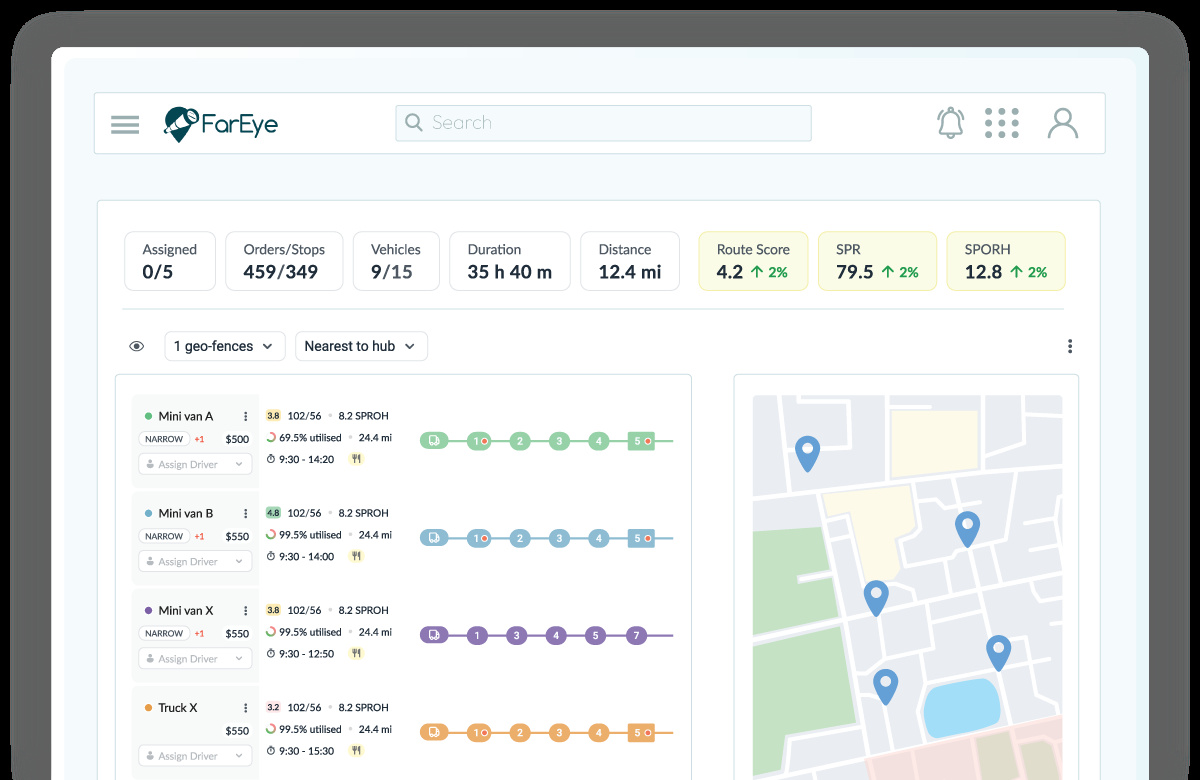- Route
Optimizing Resource Allocation: Why Multi Stop Route Planning is a Must Have for High Volume Deliveries
Table of Contents
- Why Multi Stop Route Planning Matters in High Volume Deliveries?
- What is Multi Stop Route Planning?
- Key Benefits of Multi Stop Route Planning
- Challenges Solved by Multi Stop Route Planning
- How Multi Stop Route Planning Works?
- FarEye: The Ultimate Multi Stop Route Planning Solution
- Take Control of Your Delivery Operations

The demand for faster, cheaper, and greener deliveries has never been higher. eCommerce revenue is expected to hit $8 trillion by 2027. A huge part of this growth depends on last-mile deliveries. However, last mile delivery is not cheap. It accounts for 41% of total supply chain costs, making it the most expensive stage in logistics.

For dispatchers and supply chain managers, this challenge is massive. They must balance efficiency, costs, and customer satisfaction. Multi stop route planning is the solution. It optimizes routes, reduces costs, and speeds up deliveries. Businesses that use it stay ahead. Those that don’t struggle to keep up.
This blog explores the power of multi stop route planning and how it transforms high volume deliveries.
Why Multi Stop Route Planning Matters in High Volume Deliveries?
High-volume deliveries demand precision. Multiple delivery points, time windows, and vehicle capacities increase the complexity by manifolds. Without optimization, costs can spiral out of control. Late deliveries hurt customer trust. Inefficiencies impact the bottomline.
Multi-stop route planning is essential. It ensures every vehicle takes the shortest, fastest, and most cost-effective route. It also improves fleet utilization. Businesses move more shipments with fewer resources. The result? Faster deliveries, lower costs, and higher customer satisfaction.
What is Multi Stop Route Planning?
Multi stop route planning creates the most efficient routes for multiple delivery stops. Unlike simple navigation, it considers real world factors like:
- Traffic conditions and congestion
- Delivery time windows
- Vehicle load capacities
- Driver schedules
- Regulations and sustainability goals
Businesses use this data to meet service level agreements (SLAs) and reduce costs. Advanced route planning ensures drivers reach destinations on time, every time.
Key Benefits of Multi Stop Route Planning
- Reduced Operational Costs
Fuel costs drain budgets. Every extra mile adds to expenses. Multi stop route planning cuts unnecessary travel. AI powered algorithms map the shortest and most fuel efficient paths. Features like “green windows” schedule deliveries during low traffic hours. This strategy lowers fuel consumption and reduces congestion. - Better Fleet Utilization
Many companies waste money by underutilizing vehicles. A well optimized route plan fixes this. It ensures trucks carry full loads and meet weight and volume constraints. Fewer vehicles handle more deliveries. This boosts efficiency and lowers costs. - Faster Deliveries
Traffic jams and poor planning cause delays. Multiple location route planners analyze real-time traffic and adjust routes instantly. Drivers avoid congested areas and take the quickest path. This ensures deliveries arrive on schedule, keeping customers happy. - Improved Customer Experience
Customers expect fast and accurate deliveries. Multi stop route planning provides accurate ETAs, live tracking, and real-time notifications. Customers stay informed. They know exactly when their package will arrive. This builds trust and loyalty.
Challenges Solved by Multi Stop Route Planning
- High Delivery Costs
Fuel prices, vehicle maintenance, and inefficient routes inflate delivery costs. Multiple route planners optimize every trip. They minimize travel distances while considering real-time variables like traffic and weather. - Capacity and Shift Utilization
Managing driver rosters and fleet capacity is tough. Multi stop route planners balance workloads, ensuring vehicles and drivers operate at peak efficiency. This maximizes shift utilization and reduces downtime. - Navigating Congestion
Road closures and traffic spikes disrupt deliveries. A multi stop route planner adjusts in real time. It reroutes vehicles instantly, keeping deliveries on track. - Sustainability Goals
Businesses must cut emissions. Optimized routes mean lower fuel consumption. They also enable green windows that reduce environmental impact. Companies meet sustainability goals while saving money.
How Multi Stop Route Planning Works?
Step 1: Data Collection
The system gathers essential details:
- Delivery addresses
- Time windows/SLAs
- Vehicle specifications
- Driver availability
- Real-time traffic conditions
Step 2: Constraint Analysis
- Advanced algorithms assess multiple constraints:
- Delivery time slots
- Vehicle load capacities
- Driver schedules
- Traffic patterns
Step 3: Route Optimization
AI and machine learning generate the most efficient routes. These plans minimize travel time and costs while ensuring smooth deliveries.
Step 4: Dynamic Re-Routing
Unexpected delays happen. The system dynamically reroutes drivers. Real-time updates ensure minimal disruptions.
Step 5: Performance Tracking
The system analyzes delivery performance. Metrics like on-time rates, fuel consumption, and driver productivity highlight areas for improvement.
FarEye: The Ultimate Multi Stop Route Planning Solution
FarEye tackles the biggest challenges in high volume deliveries. Its AI powered routing solutions help businesses cut costs, boost efficiency, and meet sustainability targets.
Key features of FarEye’s multi stop route planner
- Real-Time Dynamic Optimization
FarEye’s AI driven routing system continuously adapts. It adjusts routes based on live traffic, weather, and delivery changes. This reduces delays and increases efficiency. - Customized Routing Solutions
Different businesses have different needs. Whether managing LTL/FTL shipments, parcel deliveries, or hyperlocal routes, FarEye customizes solutions. Features like the comingling of loads and rate-based routing maximize cost savings. - Combining New Orders with Planned Orders
FarEye's system intelligently combines new orders with pre-planned orders for the next day, all within the same route. This approach improves capacity utilization by minimizing empty space on delivery vehicles, leading to optimized fleet performance and reduced operational costs. - Plug-and-Play Routing API
FarEye integrates seamlessly with existing systems. Businesses can optimize routes instantly without disrupting operations. The result? Faster implementation and better scalability. - Sustainability-Focused Features
FarEye supports eco-friendly logistics. It optimizes routes for electric vehicles (EVs) and offers "green windows" for lower emissions. Companies align with sustainability goals while reducing costs.
Take Control of Your Delivery Operations
Multi stop route planning is a game changer. It eliminates waste, reduces costs, and improves customer satisfaction. Companies that embrace its scale operations efficiently and stay ahead of the competition.
FarEye provides cutting edge solutions to streamline deliveries. Its AI-powered platform optimizes routes, boosts fleet efficiency, and helps businesses meet sustainability goals. Now is the time to invest in smart logistics.
Transform your delivery operations with FarEye’s advanced multi stop route planning technology.

Komal Puri is a seasoned professional in the logistics and supply chain industry. As the AVP of Marketing and a subject matter expert at FarEye, she has been instrumental in shaping the industry narrative for the past decade. Her expertise and insights have earned her numerous awards and recognition. Komal’s writings reflect her deep understanding of the industry, offering valuable insights and thought leadership.
Let's Talk to Our Experts and Optimize Your Deliveries Today!
An expert from our team will reach out within 24 hours
Related resources


